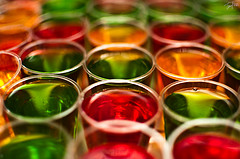As Four Loko Furor Wanes, Jell-O Shots Still Substantial Part of Underage Drinking, Study Finds
Alcoholic gelatin shots still represent a “substantial proportion” of how underage drinkers obtain alcohol, with one in five study participants reporting having one shot in the last 30 days, says a new study led by Boston University School of Public Health researchers.
The pilot study, published online in the journal Substance Use and Misuse, is the first of its kind to report on the prevalence of alcoholic gelatin shot consumption among adolescents, said lead author Michael Siegel, professor of community health sciences at BUSPH. Gelatin shots, commonly referred to as “Jell-O shots,” are an alcoholic beverage made by preparing gelatin but substituting alcohol for some of the water.
While there has been a nationwide furor over alcohol-infused whipped cream and caffeinated alcoholic beverages like Four Loko — the FDA recently banned the drinks — gelatin shots have largely remained under the radar, Siegel said.
“We did a thorough search of literature and didn’t find any other study that’s been published that actually measured Jell-O shot consumption,” Siegel said. “Part of the danger is that Jell-O shots don’t have the same visibility as, for example, caffeinated alcoholic beverages do. Underage drinkers aren’t thinking of Jell-O shots that way.”
“If it’s true that one-fifth of youth drinkers are using Jello shots, then we’re getting an underestimate of youth alcohol intake in our national surveys … (because we’re) leaving out a significant form of consumption,” he said.
Siegel and his co-authors studied a nationwide sample of 108 underage drinkers, ages 16-20, on their consumption of alcoholic gelatin shots. The nonrandom study found that 21.4 percent had consumed one in the past 30 days. They also found that consumption of gelatin shots was associated with riskier drinking behavior, such as binge drinking, defined as five or more drinks in a row.
“The clear limitation is that this is a preliminary study, with only 108 subjects,” Siegel said. “We can’t draw accurate national conclusions as to what the exact prevalence of Jell-O shot use is among underage drinkers because we don’t have a large, random sample but we are hoping to do a larger, follow-up study.”
The authors found that while 58.5 percent of nonusers of alcoholic gelatin shots reported binge drinking, 92.9 percent of gelatin shot users reported binge drinking, the authors wrote.
The researchers note that alcoholic gelatin shot consumption among underage youth is worth further research for several reasons. First, there is strong evidence that gelatin is an effective alcohol delivery device. Second, youths are vulnerable to intoxication from gelatin shots because the sugary shots mask the bitter taste of alcohol, making it easier for young alcohol users to ingest larger quantities. Third, alcoholic gelatin shots combine a familiar, widely available, and appealing product — gelatin — with alcohol, which may “enhance the initiation of alcohol use among novice drinkers.”
The study was supported by a grant from the National Institute on Alcohol Abuse and Alcoholism.
Besides Siegel, authors on the study include Jane Binakonsky and Noreen Giga, both of the Department of Community Health Sciences at BUSPH; and Craig Ross of Virtual Media Resources based in Natick, Mass.
Submitted by Elana Zak, ezak@bu.edu